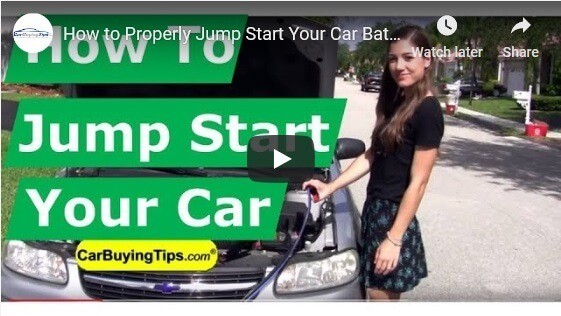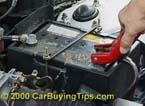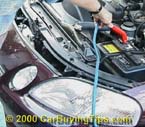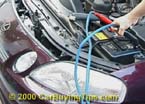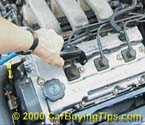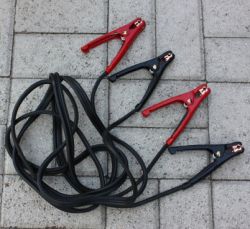How to Jump-Start a Car
Preparation for Jump-Starting a Dead Car Battery
- Line both cars up so the batteries are as close as can be. Make sure the cars are in park, and both cars are turned off and not touching each other before you connect the cables. Actually one of them is already off, or you wouldn't be in this predicament right?
- Make sure all headlights, blinkers, car radios and A/C's are off. Unplug all accessories from cigarette lighters and power sockets from both cars.
- Familiarize yourself with the Positive (+) and Negative (-) terminals of both car batteries. All batteries are clearly marked. Wipe off any corrosion.
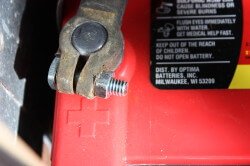
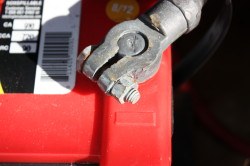
- If the battery is cracked and liquid is leaking out, DO NOT go further! Buy a new battery and swap it out. If you try to jump-start a battery that is cracked, it may explode.
- Clean off any corrosion around the dead battery terminals. If you have tools, loosen the wires from the terminals, clean them off, then re-tighten the wires to the clean posts. If you have a file handy, try to file the metal battery posts until they are nice and shiny. In a pinch use pliers to clamp down and scrape off the corrosion.
- Usually the positive battery cable is red or orange and the Negative (-) or ground cable is black. Always check to be sure.
Watch our How to Jump-Start a Car Battery Video
You can access it at CarBuyingTips.com - Dead Battery Video. If you have the YouTube app on your phone you should bookmark this video so you can get to it when you really to need it.
Connecting the Car Battery Jumper Cables
The cables must be connected in this exact order listed below. Wear eye protection! Click on the thumbnail pictures for a larger view.
Step 1: Connect one end of the Positive (+) cable to the Positive (+) post of the dead battery.
Step 2: Connect the other end of the Positive (+) cable to the Positive (+) post of the good battery.
Step 3: Connect one end of the Negative (-) cable to the Negative (-) post of the good battery.
Step 4: Connect the other end of the Negative (-) cable to a good solid shiny, non painted metal part of the engine on the dead car. Usually a bolt on the engine block will do. You want to avoid placing the Negative (-) cable directly on the dead battery to minimize the chance for an explosion. You should only use the post on the dead battery as a last resort. You'll get a spark as you connect the ground, this is normal.
Starting Method
Start the good car's engine and make sure the headlights are off to allow the maximum amount of power to get to the dead battery. Let the good car's engine run a minute or so before attempting to start the dead car. Sometimes you get lucky and the dead car will turn over right away, sometimes it takes a few minutes. If your dead car's interior dome light comes on, it's a great sign that you've connected the cables right. Now shut all doors and dome lights and try to start the car. If it sounds like it's trying to crank but won't turn over completely, give it a few more minutes and rev the engine moderately on the good car. You may also need to play with the cable grips to get a better connection. Normal sparking occurs as you move the cables around. If you couldn't get the dead car to start, see the troubleshooting section further own this page.
Removing the Jumper Cables
Now that your dead car has been successfully jump-started, you can remove the cables in the reverse order that you connected them in. Be careful to avoid letting the cable clamps touch each other:
- Disconnect the Negative (-) cable from the engine block of the car that was jump-started.
- Disconnect the other end of the Negative(-) cable from the Negative (-) post of the good battery.
- Disconnect the Positive (+) cable from the Positive (+) post of the good battery.
- Disconnect the other end of the Positive (+) cable from the Positive (+) post of the dead battery.
Check if the Car Can Restart
After your revived car has been running a few minutes, turn off the engine and see if it will restart on its own, no cables attached. This is a good test to see if your charging system is working, and if successful, it's a good indicator that you won't have problems driving home. If the engine cannot crank on it's own, you'll have to jump-start the car again and it may mean you'll have problems getting home. If your car does not restart on its own, it's a sign that something is really wrong, either the battery is bad or your charging system has a problem. Have someone follow you home.
Jump-Start Troubleshooting Tips
If you tried the steps above and your car still won't start it is possible that the dead battery is not getting voltage from the good battery due to bad cables or a bad connection from the good battery.
- Play with the cables a bit to be sure you get a good connection. You'll see sparking as you adjust the clamps, which is normal.
- Try disconnecting the Negative (-) cable from the dead car's engine block, and try moving it over to the Ground (-) post of the dead battery, if the dead battery is not leaking. Keep in mind there is always risk of battery explosion, but I've never had a problem. Wear protective eye wear! Don't take any chances. Remember, if you don't see your instrument panel light up, or dome light turn on then you don't have a good jumper cable connection.
- Try another set of cables. It could be that the cables you're using are no good.
- Verify once again that all electronics are off. Nothing should be on, the doors should be closed during the cranking process so the dome light is not on.
- Double check that there is no corrosion, rust or anything other than nice shiny metal on the battery posts. Scrape off the corrosion with a fingernail file if you have to, but you want nice shiny posts when you're done.
- If the cables are real warm and you're not having success, it's a sign that your jumper cables have a problem. Jumper cables that are frayed or rusty at the clamps may not work.
- If all else fails, call a tow truck or AAA.
Auto parts stores can quickly diagnose your dead car battery for free! Have your battery tested before you buy a new battery so you know if it is the problem.

